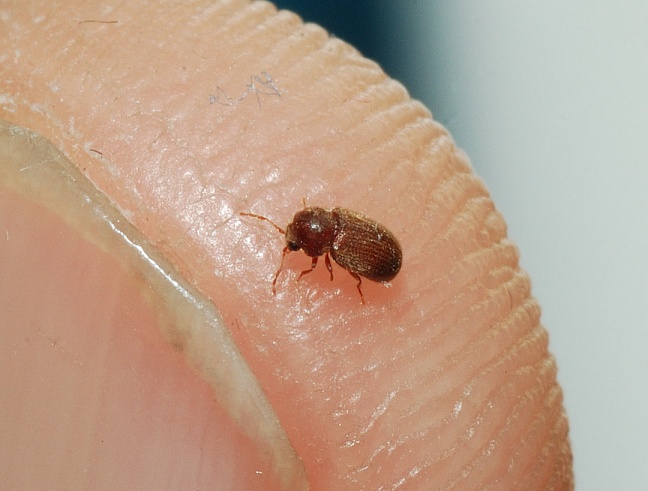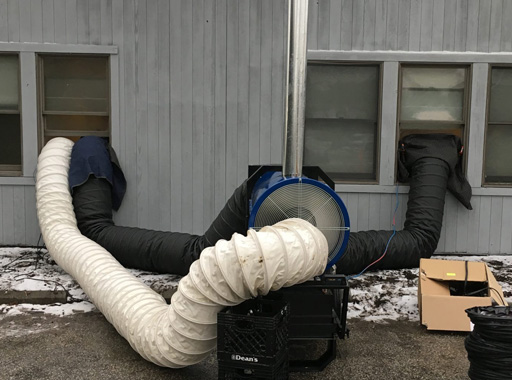In this post we’ll be exploring how to get rid of and prevent biscuit beetles, as well as other common questions people have about this insect.
Before we dive into how to get rid of them, let’s first establish what we are dealing with when we refer to a ‘biscuit beetle’.
What is a Biscuit Beetle?
The biscuit beetle, known scientifically as Stegobium paniceum, is a common food pest also referred to, in the US, as the drug store beetle. This species garners its name from its notorious history of infesting products on the shelves of pharmacies, but today, they are better known for their attacks on biscuits and other foods.
Does the UK Have Biscuit Beetles?
Yes, biscuit beetles are found in the UK, among many other regions around the world.
What does a Biscuit Beetle Look Like?
Biscuit beetles are small insects measuring about two to three and a half millimetres in length. They have a rounded cylindrical body that is dark brown and possess elytra, which are hardened wing cases that protect their wings while at rest. There’s a picture of a biscuit beetle below so you can see what they look like.


What does a Biscuit Eat?
These beetles have a diverse diet, feeding on a range of dried products. You’ll find a list below:
- Biscuits
- Cereals
- Flour
- Bread
- Cakes
- Dried beverage like powdered milk
- Dried fruits and vegetables
- Dry pet foods
- Beans and lentils
- Chili peppers and other spices
- dry capsule medicine
It is the larvae that cause the most damage as they need to feed and grow within the infested food materials. The adults don’t actually eat, but they might still chew through packaging to reach a food source to lay eggs.
What Other Beetles Eat Biscuits?
Other grain-loving pests that might invade your biscuits include:
- Flour Mite/Grain Mite (Acarus siro)
- Broadhorned Flour Beetle (Gnatocerus cornutus)
- Coffee Bean Weevil (Araecerus fasciculatus)
- Confused Flour Beetle (Tribolium confusum)
- Foreign Grain Beetle (Ahasverus advena)
- Granary Weevil (Sitophilus granarius)
- Cigarette Beetles (Anobiidae)
If you think you have biscuit beetles you need to make sure it’s not something else before you tackle it, in order to apply an effective treatment.
What are the Signs of Biscuit Beetles?
Indications of an infestation include the presence of the beetles themselves on shelves and in food, damaged packaging where adults bore through to reach food to lay eggs, and the holes in the food, created by larvae.
How do Biscuit Beetles Get into Your Home?
They often enter homes through infested food items brought home from the shops.
How to Get Rid of Biscuit Beetles
Getting rid of biscuit beetles normally involves a combination of cleaning, discarding infested items, and using appropriate insecticides.
Here’s how to get rid of biscuit beetles:
Identify the Pest
Properly identifying the pest is crucial to ensuring the correct treatment method. Assuming you are sure you have biscuit beetles, then follow these steps:
Inspect for Activity
Check your cupboards and other places where your food is stored. Look for adult beetles and focus on finding the source of the infestation, such as grains, flours, or dry pet food.
Clean and Clear
Before treatment, throw out pest-infested food packages, especially those with grains and flours. Take the rubbish bin fill of infested foods outside straight away.
Biscuit beetles can chew through packaging, particularly carboard, so it’s essential to discard anything that is suspect.
Then, vacuum all crevices in your cupboards, paying attention to shelving peg holes and similar tight spaces.
Apply Insecticides (if you are ok with chemicals)
For chemical control, use products labelled for treating biscuit beetles. If you can find an aerosol insecticide it will be ideal for cracks and crevices. Biscuit beetles are very small, so they can easily hide in tiny hole and reinfest new foods.
You might also find other chemicals that will help prevent reinfestation. Have a look on Amazon.
When using chemicals, be sure that there is no food anywhere near the area being treated. Always read and follow the label and its safety information.
Chemical vs Non-Chemical Treatments
The use of chemicals can provide a quick solution and long-lasting prevention. However, they must be used carefully to avoid contamination of food surfaces and to ensure the safety of pets and humans.
Non-chemical DIY methods for managing biscuit beetles are the same we outlined above, but just without using chemicals
While non-chemical methods are safer, they may just require some extra diligence and persistence to get rid of the pest.
Pest control professionals such as Merlin Environmental use heat treatment to get rid of biscuit beetles, without any needing chemicals.
We have special industrial heating equipment that we can deploy to heat an entire room to 55 degrees celsius, which will eliminate every living insect, in every crack and crevice, in the whole room, with a 100% success rate. If you’re interested in this get in touch.

How to Prevent Biscuit Beetles Returning
Inspect Regularly
Regularly inspect your cupboards and where packaged foods are stored. Look for beetles or signs of infestation, especially in grains, flour, biscuits, and dry pet food.
Proper Storage
Store all dry goods such as cereals, rice, and flour in tightly sealed containers whether the packets have been opened or not. Plastic Tupperware or similar airtight containers are recommended, particularly for pet food and birdseed which are often targets for these pests.
Buy in Small Quantities
Only purchase about a week or two’s worth of food at a time. Overstocking your kitchen cupboards can increase the risk of infestation as pests have more food to infest, and overcrowded food storage cupboard makes it more difficult to see signs of infestation
Examine Packaging
When buying dry foods, inspect the packaging for any signs of damage such as holes, rips, or tears which could indicate an infestation.
Throw things out
Keen an eye on what’s out of date and bin it. The same goes for packets that haven’t been used and have gone stale.
Good Hygiene and cleaning
Keep your food areas clean. Vacuum all cracks and crevices each week, and wipe down shelves with water to remove food residues.
Be thorough in your cleaning, ensure you reach the backs of shelves, inside peg/screw holes, and vacuum the area for crumbs.
Freezing
For items you suspect might be infested put them in the freezer for 7 days. The sub-zero temperature will kill any larvae, eggs and adult biscuit beetles present in the food.
Do Biscuit Beetles Fly or Bite?
Yes, biscuit beetles can fly, but no, they do not bite humans.
What Happens if You Eat a Biscuit Beetle?
While not ideal, accidentally consuming a biscuit beetle or its larvae is not known to cause harm to humans. However, the presence of these beetles can indicate unsanitary conditions in your kitchen, so you might want to give the whole place a good clean.
Summary
Biscuit beetles can cause extensive damage to food products and can result in high grocery costs, as impacted food will need to be thrown out and likely replaced.
By identifying these pests correctly, taking prompt action to eliminate them, and employing preventative measures, you can protect your home or business from future infestations.
If you need help identifying whether you have biscuit beetles, or if you want assistance in getting rid of biscuit beetles, always ask a pest control expert.
Merlin Environmental is a UK pest control company offering nationwide pest control solutions for biscuit beetles and other insects. If you have a pest problem reach out to us.

